For safe and accurate wild berry identification, PictureThis offers the highest accuracy (98%) but requires payment, while free alternatives like PlantNet and iNaturalist provide solid identification with community verification. Look for apps with offline capabilities, toxic lookalike warnings, and regional specificity for your foraging area. Using multiple apps for cross-reference verification greatly increases identification confidence. The right digital tool can mean the difference between a delicious harvest and a dangerous mistake.
Why Wild Berry ID Apps Are Essential for Safe Foraging
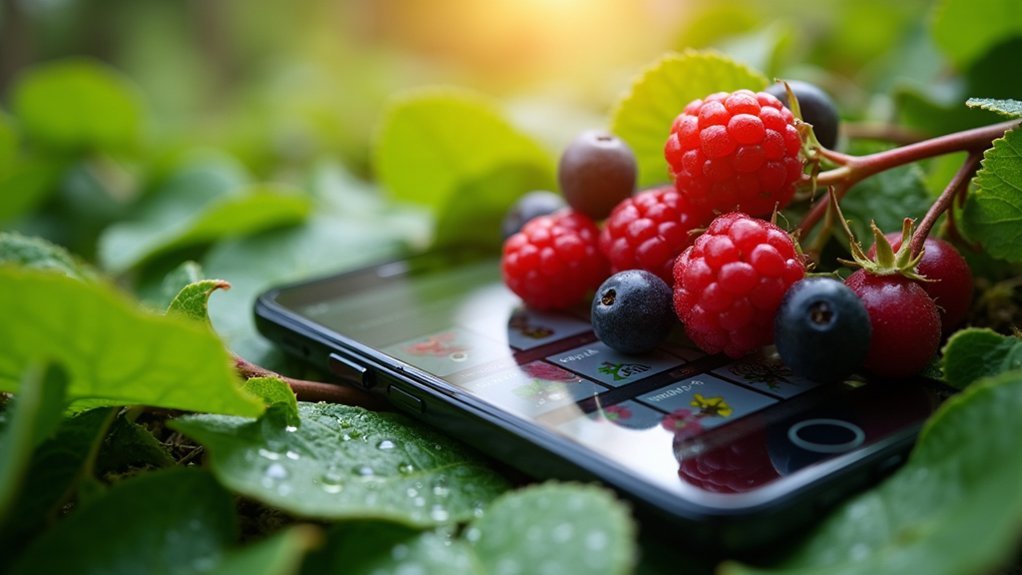
While the allure of foraging for wild berries can be irresistible, proper identification is absolutely critical for your safety. Consuming misidentified berries can lead to serious poisoning, making reliable identification tools non-negotiable for any forager.
Wild berry ID apps like PictureThis, iNaturalist, and Wild Edibles Lite give you instant access to vast plant databases, even in areas without internet connection. They're particularly valuable when you're exploring unfamiliar regions with different native species or during various seasons when availability changes.
Beyond safety, these apps enhance your environmental awareness by teaching you about berry ecosystems and sustainable harvesting practices. Many foragers need to be aware of look-alike plants that may appear similar to edible species but could be toxic. They also help you navigate legal considerations, ensuring you don't inadvertently violate local regulations when gathering nature's bounty.
Top-Rated Berry Identification Apps of 2023
Now that we've established why berry ID apps are essential for foragers, let's examine which apps stand out in 2023.
PictureThis leads the pack with an impressive 73% accuracy rate, though it requires payment for full functionality. Many users found the persistent advertising for the paid version distracting while using the free version.
For free options, PlantNet offers exceptional identification capabilities with its database of over 46,050 plant species and works offline—perfect for remote foraging trips.
iNaturalist stands out for its user-friendly interface and community features, making it ideal for educators and citizen scientists.
For specialized foraging, Wild Edibles Lite focuses specifically on edible plants and includes recipes alongside identification information.
To maximize your success rate, consider using multiple apps together, especially when identifying potentially dangerous wild berries in unfamiliar terrain.
PictureThis: The Most Accurate Plant Recognition Tool

PictureThis stands out with its AI-powered berry detection system that identifies over 400,000 plant species with 98% accuracy.
You'll appreciate the app's offline identification capabilities, allowing you to spot berries even in remote areas without cell service.
The app's poisonous lookalike warnings provide essential safety information, alerting you to potentially dangerous berries that resemble edible varieties.
PictureThis also offers detailed safety warnings for plants that may be toxic to pets and children, making it an essential tool for families who forage together.
AI-Powered Berry Detection
Advanced neural networks form the technological foundation of PictureThis, making it a standout tool for wild berry identification. The app's AI system has been trained on millions of plant images, enabling it to recognize over 450,000 plant varieties, including numerous wild berries.
When you're foraging, simply snap a photo of an unknown berry plant, and the neural network analyzes it instantly. You'll receive detailed information about the species, including whether it's edible or toxic—critical knowledge for safe foraging. With 95% accuracy rate, PictureThis ensures reliable identification of potentially dangerous look-alike species.
The app's smart search function also lets you describe plants by characteristics when taking photos isn't possible. PictureThis continuously updates its database with new scientific information, ensuring you're getting accurate, current identifications during your foraging adventures, all through an intuitive interface available on both iOS and Android.
Offline Identification Capabilities
For foragers venturing into remote wilderness areas, reliable offline identification capabilities are essential when cell service becomes spotty or non-existent. The best berry ID apps understand this vital need.
Flora Incognita, iNaturalist, and PlantNet lead the pack with robust offline features. You can take photos, store observations locally, and sync data later when connectivity returns. Among these options, PlantNet offers a community-driven platform where users can share and compare their findings once back online.
While iNaturalist primarily requires internet for full functionality, it still allows you to log findings offline.
These capabilities span across both Android and iOS platforms, with most apps aiming for consistent experiences regardless of your device. The offline features not only enhance your foraging safety but also allow you to contribute valuable data to global plant databases—even from the most remote locations.
For serious foragers, these offline tools transform how you identify and learn about wild berries.
Poisonous Lookalike Warnings
When foraging for wild berries, the difference between a delicious treat and a dangerous toxin can be deceptively subtle. PictureThis excels at alerting you to dangerous lookalikes that might fool even experienced foragers.
The app specifically highlights poisonous berries like Virginia creeper and nightshade that resemble edible grapes and blueberries but contain potentially fatal compounds. You'll receive clear warnings about these deceptive similarities. Consuming just a handful of pokeberries can be lethal to children while larger amounts can kill adults.
| Poisonous Berry | Resembles | Toxic Compounds |
|---|---|---|
| Virginia Creeper | Grapes | Oxalate crystals |
| Nightshade | Blueberries | Toxic alkaloids |
| Pokeweed | Grapes | Gastrointestinal toxins |
Don't rely on color alone—many toxic berries come in tempting purple, red, and black shades. PictureThis provides thorough visual comparisons that could literally save your life when you're uncertain about a wild find.
Regional Apps for Local Berry Identification
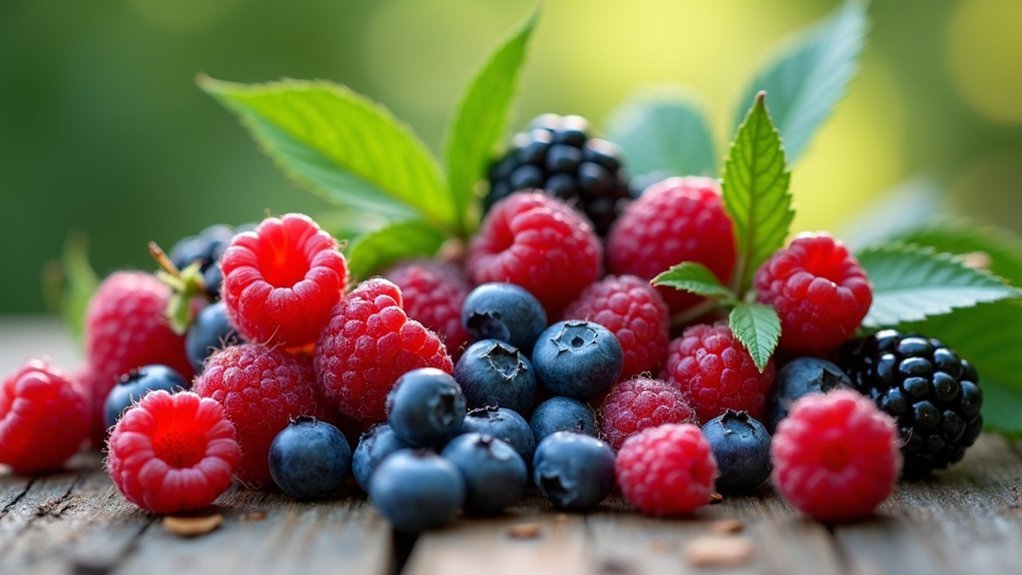
While general plant identification apps offer broad coverage, region-specific apps provide superior accuracy for local berry foraging. Apps like PlantNet let you search based on regional flora, helping you identify berries native to your specific location.
Region-specific plant ID apps outperform general ones for local foraging, pinpointing native berries with greater precision.
For North American and European foragers, Wild Berries and Herbs LITE offers extensive coverage with over 2,000 images and region-specific information.
Many apps now include features to identify edible wild berries that are safe for children to forage, making outdoor family activities more educational and engaging.
If you're exploring the Pacific Northwest or Arctic regions, look for specialized guides that account for unique species and climate conditions.
Complement these digital tools by connecting with local foraging communities and forums where experienced gatherers share knowledge about seasonal availability and hidden spots.
The best approach combines technology with regional expertise—your phone can identify the berry, but locals know where to find the best patches.
Offline Features for Remote Foraging Adventures
Venturing deep into the wilderness demands berry identification apps that won't leave you stranded when cell service disappears.
Flora Incognita stands out with robust offline capabilities, offering AI-based plant identification and location mapping even without connectivity.
While Imagine This provides basic offline functionality, it requires internet for accurate identifications.
Wild Berries and Herbs LITE offers extensive plant information that's accessible offline, including images and descriptions vital for berry identification on remote trails.
For educational support during off-grid adventures, consider Foraging Flashcards Lite to test your knowledge, though it lacks advanced features and only focuses on name recognition without providing detailed plant information.
Wild Edibles Lite provides valuable nutritional information and descriptions that don't require connectivity, making it useful when exploring remote foraging locations where internet access is unavailable.
Community-Based Apps for Expert Verification
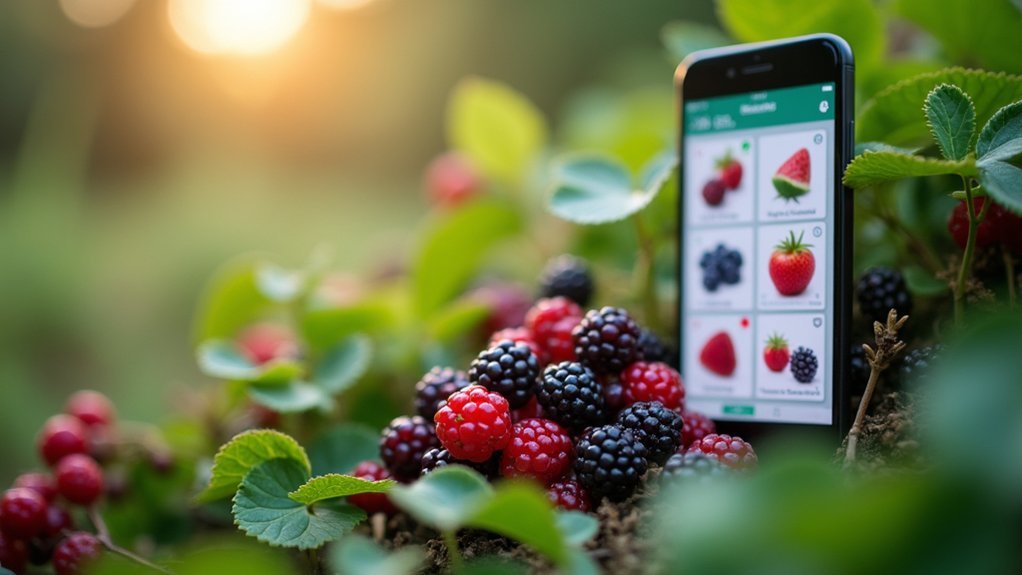
When you're uncertain about a wild berry's identity, community-based apps can connect you with expert foragers for verification.
Apps like iNaturalist leverage crowdsourced knowledge through a network of naturalists who review and confirm your observations, substantially increasing identification accuracy.
These expert response networks transform solitary foraging into a collaborative experience, allowing you to benefit from regional expertise while contributing valuable data to conservation efforts. Seek by iNaturalist offers a family-friendly alternative that uses image recognition technology to help identify species without requiring registration or collecting user data.
Crowdsourced ID Verification
Four of the most powerful foraging apps leverage the collective knowledge of thousands of users worldwide through crowdsourced verification systems.
When you're uncertain about a berry's identity, these platforms connect you to experts who can confirm or correct your findings in real-time.
iNaturalist leads with its "Research Grade" designation for thoroughly verified observations, while PlantSnap offers unlimited access to botanists for premium users.
Seek's gamified approach uses badges to encourage ongoing participation. PlantSnap's extensive database of 650,000+ plants ensures comprehensive coverage for even the most obscure wild berries you might encounter.
- Community Engagement – Multiple users review and confirm your identifications, dramatically improving accuracy
- Open Data Contributions – Your verified observations feed into scientific databases used by researchers
- Cross-Verification – Having several experts validate the same berry provides confidence before consuming
These systems work even for rare species that automated systems might miss.
Expert Response Networks
Beyond basic crowdsourcing, several high-quality apps now offer direct connections to certified botanists and foraging specialists through expert response networks.
These services provide private consultations where you'll receive personalized feedback on your berry photos with rapid response times and greater accuracy than public forums.
You'll benefit from extensive databases maintained by trained mycologists and botanists who specialize in regional flora.
Many networks incorporate AI-assisted identification for initial screening before expert review, ensuring reliable results while maintaining efficiency.
The best apps facilitate mentorship through expert-client feedback loops, giving you access to educational resources like webinars and guided foraging events.
This combination of technology and human expertise greatly reduces misidentification risks while helping you build valuable foraging skills through trusted, credible sources.
These apps can help you identify whether berries like elderberries require cooking before consumption, preventing potential health issues from improperly prepared wild foods.
Visual Guides and Photo Recognition Technology
Modern berry identification apps leverage cutting-edge visual guides and photo recognition technology to transform your foraging experience. Apps like PlantNet catalog over 23,000 plant species worldwide, while platforms such as PictureThis employ sophisticated AI algorithms for accurate identification.
These tools offer:
Modern foraging apps provide essential identification features that transform how we interact with and understand edible plants in the wild.
- Targeted identification features – analyze specific plant parts like leaves, flowers, and berries to distinguish between similar species.
- Regional specialization – apps like DenaliFlora focus on local ecosystems, offering offline functionality for remote foraging areas.
- Color-based assessment – help you recognize that darker berries (blue, purple, black) are generally more reliable for edibility than lighter-colored ones.
The technology continuously improves through regular updates, making berry identification more accessible and efficient for both novice and experienced foragers. Some apps like iNaturalist provide crowdsourced suggestions from a social network of naturalists to verify your berry identification.
Educational Features in Modern Foraging Apps
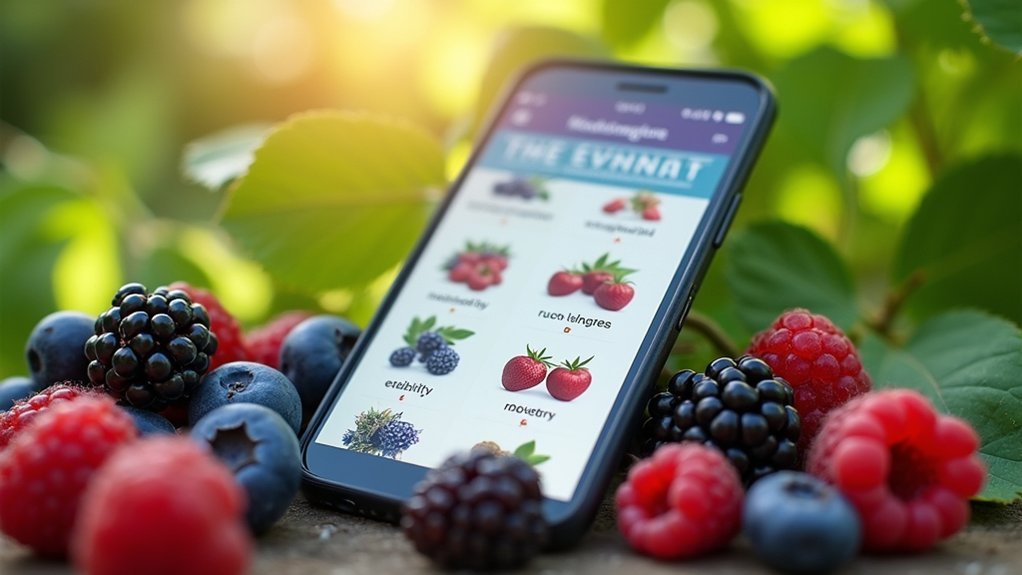
Modern foraging apps offer interactive lessons that transform your berry-picking adventure into an extensive learning experience.
You'll find step-by-step tutorials on berry identification techniques, complete with quizzes that reinforce your knowledge in real-time while you're in the field.
These apps also connect you directly with botanists and experienced foragers who can answer your specific questions about wild berries through comment sections and live Q&A sessions. Most advanced apps include comprehensive safety guidelines to help users distinguish between edible berries and potentially dangerous look-alikes.
Interactive Learning Tools
Today's foraging apps offer far more than simple identification – they've evolved into extensive educational platforms.
These interactive tools transform plant recognition into an engaging learning experience, helping you build confidence in your foraging abilities through hands-on practice.
Most cutting-edge foraging apps include:
- Quiz-based learning systems that test your identification skills through gamified challenges, tracking your progress as you master different species. One standout example offers a comprehensive quiz game that helps users learn to distinguish between 180 different species through pictures.
- Visual identification guides that walk you through distinguishing characteristics of similar-looking berries, reducing the risk of misidentification.
- Community features where you can share your findings, ask questions about uncertain specimens, and receive feedback from experienced foragers.
These interactive elements guarantee you're not just collecting information but actively developing practical skills that translate directly to safer, more successful foraging expeditions.
Expert Knowledge Access
Why trek through wilderness with outdated field guides when you can tap into cutting-edge botanical expertise through your smartphone?
Today's foraging apps connect you directly to expert knowledge that once required years of mentorship.
Apps like Wild Edibles and PlantSnap offer access to botanists' insights through detailed plant descriptions, growth patterns, and habitat preferences.
You'll find expert advice on harvesting techniques, preparation methods, and potential look-alikes to avoid. Many platforms include nutritional information alongside traditional and medicinal uses. These apps provide crucial safety protocols for identifying toxic look-alikes, which is paramount for successful foraging experiences.
For verification, iNaturalist links you to a global community of naturalists who can confirm your identifications.
When you're uncertain about a particular berry, simply upload a photo and receive expert feedback—often within hours.
This instant access to specialist knowledge dramatically reduces the learning curve for new foragers.
Seasonal Tracking and Harvest Timing Tools
Knowing when wild berries reach their peak ripeness can dramatically improve your foraging success. Most plant ID apps now incorporate seasonal tracking features that help you anticipate when different berries will be ready for harvest in your region.
- Weather-Based Predictions – Apps can monitor how local conditions like cool, wet springs might delay ripening times for berries like raspberries and blackberries. Always remember to leave some fruit for wildlife when harvesting to maintain the local ecological balance.
- Location-Specific Timing – Your region's soil composition affects harvest seasons—blueberries thrive in dry, sandy soils found in mountainous areas, while raspberries prefer farmlands rich in organic matter.
- Spring Scouting Alerts – Set notifications to remind you when it's time to scout potential berry patches, giving you a head start on monitoring their development through summer and fall.
Apps With Toxic Lookalike Warnings
Perhaps the most essential feature of any wild berry identification app is its ability to warn you about dangerous lookalikes. Several apps excel in this critical safety aspect.
iNaturalist flags Virginia creeper berries that resemble blueberries but are toxic. PictureThis offers detailed warnings about both deadly and bittersweet nightshade varieties, which can be fatal if consumed.
PlantNet provides identifications based on leaf and berry images with specific toxic plant warnings. Be cautious with Google Lens, as it sometimes misidentifies poisonous plants.
While Rash Plants helps identify poison ivy, it's not exhaustive for berry identification. Good apps should distinguish between edible berries like elderberries and poisonous look-alikes such as water hemlock with its green or purple stems.
Remember that most apps improve through user feedback and community input. When foraging, always cross-reference identifications and never consume green, white, or yellow berries, which are frequently toxic.
Integrating Traditional Knowledge With Digital Tools
While modern technology offers impressive tools for plant identification, traditional ecological knowledge (TEK) represents centuries of human observation that many apps fail to incorporate.
Apps that effectively bridge this gap provide more extensive identification capabilities and meaningful cultural context about wild berries and their traditional uses.
When ancestral wisdom meets digital innovation, we gain not just identification, but connection to centuries of human-plant relationships.
The most promising integrations of TEK with digital tools include:
- Collaborative development between Indigenous communities and app creators to guarantee accurate cultural representations
- Bilingual support featuring Indigenous languages alongside scientific terminology
- Educational components that explain traditional harvesting practices and sustainable foraging techniques
You'll find the most valuable wild berry identification tools are those that respect and incorporate traditional knowledge while leveraging modern technology's convenience—creating a more holistic approach to plant identification that honors cultural heritage.
Subscription vs. Free Apps: What You Get for Your Money
Just as traditional knowledge adds depth to berry identification, your wallet often determines the extent of digital assistance you'll receive. Free berry ID apps typically offer basic identification with daily upload limits and ad-filled interfaces, while subscription versions provide unlimited uploads, ad-free experiences, and more extensive identification databases. Accurate identification is critical, similar to river streamflow forecasting which emphasizes the importance of precision in prediction models.
| Feature | Free Apps | Paid Subscriptions |
|---|---|---|
| Daily Uploads | Limited (5-25) | Unlimited |
| Ads | Present | None |
| ID Accuracy | Good | Excellent |
Your choice ultimately depends on your foraging frequency. Casual weekend foragers might find free options sufficient, while serious wildcrafters will benefit from paid subscriptions offering priority support, detailed care guides, and regular database updates. Consider how often you'll use the app before deciding which path to take.
Using Multiple Apps for Cross-Reference Verification
When it comes to wild berry identification, relying on a single app can be risky—even dangerous. Cross-referencing your findings across multiple platforms greatly improves accuracy and confidence in your identification.
Never gamble with wild foraging—using multiple plant ID resources isn't just smart, it's potentially life-saving.
Here's how to effectively cross-reference your berry findings:
- Combine specialist with generalist apps – Pair PictureThis (73% accuracy rate) with iNaturalist's crowdsourced verification for more reliable results.
- Document multiple angles – Take photos of berries, leaves, stems, and overall plant structure to give each app the best chance at correct identification.
- Average your results – When apps disagree, consider which one specializes in wild plants versus garden varieties, and check against botanical resources like Missouri Botanical Garden's Plant Finder for confirmation.
Frequently Asked Questions
Can Berry ID Apps IDentify Plants From Dried or Preserved Specimens?
You'll find that most berry ID apps struggle with dried specimens. They're designed for fresh plants with vivid colors and distinct features, not preserved samples which have lost their characteristic appearance through drying.
How Do Berry ID Apps Perform in Low-Light Foraging Conditions?
Berry ID apps struggle in low light. You'll find their accuracy decreases as image quality suffers. Use flash, adjust exposure settings, or wait for better lighting to improve results when foraging in dim conditions.
Are There Apps Specifically Designed for Colorblind Foragers?
Currently, there aren't apps specifically designed for colorblind foragers. You'll need to rely on general foraging apps and accessibility tools like Color Blind Pal that help with color identification while outdoors.
Can These Apps Identify Berries at Different Growth Stages?
Yes, you'll find apps like PictureThis and iNaturalist can identify berries at different growth stages, though they're more accurate with mature specimens. Submit multiple photos to improve identification accuracy for unripe berries.
How Frequently Are Rare or Newly Discovered Berry Species Added?
Rare or newly discovered berry species are typically added quarterly to yearly, depending on the app. You'll notice faster updates with apps that use crowd-sourcing, where your contributions can accelerate the inclusion process.
In Summary
You're now equipped to identify delicious wild berries with confidence. Remember to use multiple apps for verification and always prioritize safety by checking for toxic lookalikes. Whether you're using free versions or paid subscriptions, these digital tools complement traditional knowledge perfectly. Download a few options before your next adventure, and you'll transform your foraging experience while staying connected to nature's bounty.

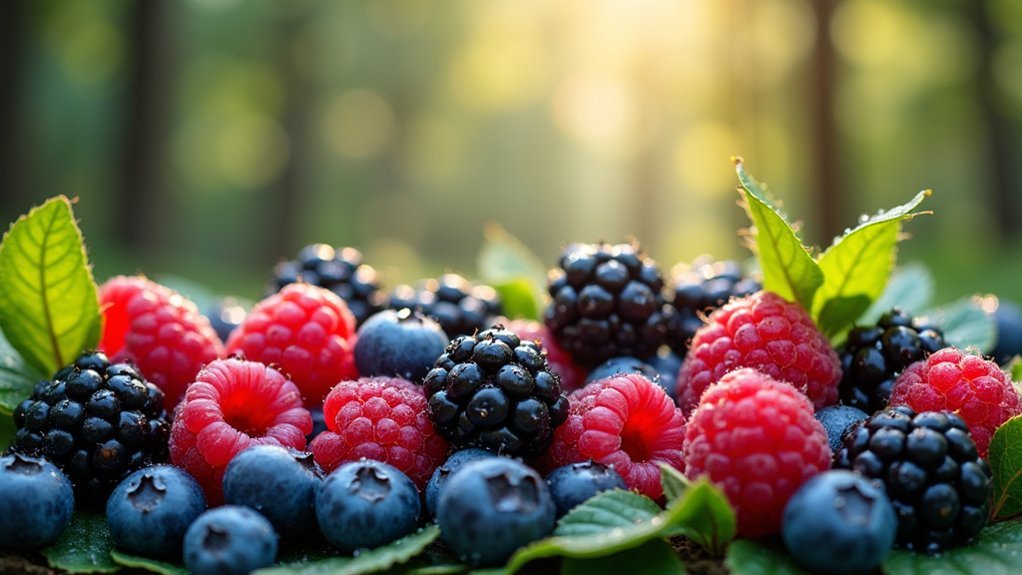



Leave a Reply